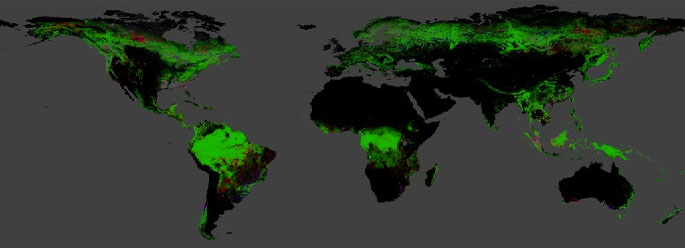


NOTE: This is version 1.0. A newer version 1.7 including forest loss through 2019 is availalbe.
Results from time-series analysis of 654,178 Landsat 7 ETM+ images in characterizing global forest extent and change from 2000 through 2012. For additional information about these results, please see the associated journal article (Hansen et al., Science 2013).
Web-based visualizations of these results are also available at our main site:
http://earthenginepartners.appspot.com/science-2013-global-forest
Please use that URL when linking to this dataset.
We anticipate releasing updated versions of this dataset. To keep up to date with the latest updates, and to help us better understand how these data are used, please register as a user. Thanks!
 This work is licensed under a Creative Commons Attribution 4.0 International License. You are free to copy and redistribute the material in any medium or format, and to transform and build upon the material for any purpose, even commercially. You must give appropriate credit, provide a link to the license, and indicate if changes were made.
This work is licensed under a Creative Commons Attribution 4.0 International License. You are free to copy and redistribute the material in any medium or format, and to transform and build upon the material for any purpose, even commercially. You must give appropriate credit, provide a link to the license, and indicate if changes were made.
Use the following credit when these data are displayed:
Source: Hansen/UMD/Google/USGS/NASA
Use the following credit when these data are cited:
Hansen, M. C., P. V. Potapov, R. Moore, M. Hancher, S. A. Turubanova, A. Tyukavina, D. Thau, S. V. Stehman, S. J. Goetz, T. R. Loveland, A. Kommareddy, A. Egorov, L. Chini, C. O. Justice, and J. R. G. Townshend. 2013. “High-Resolution Global Maps of 21st-Century Forest Cover Change.” Science 342 (15 November): 850–53. Data available on-line from: http://earthenginepartners.appspot.com/science-2013-global-forest.
This global dataset is divided into 10x10 degree tiles, consisting of seven files per tile. All files contain unsigned 8-bit values and have a spatial resolution of 1 arc-second per pixel, or approximately 30 meters per pixel at the equator.
treecover2000)loss)gain)lossyear)datamask)first)last)Reference composite imagery are median observations from a set of quality assessed growing season observations in four spectral bands, specifically Landsat bands 3, 4, 5, and 7. Normalized top-of-atmosphere (TOA) reflectance values (ρ) have been scaled to an 8-bit data range using a scale factor (g):
The g factor was chosen independently for each band to preserve the band-specific dynamic range, as shown in the following table:
| Landsat Band | g |
|---|---|
| Band 3 (red) | 508 |
| Band 4 (NIR) | 254 |
| Band 5 (SWIR) | 363 |
| Band 7 (SWIR) | 423 |
To download individual 10x10 degree granules, click on a region on the map below and then click on the URLs underneath it.

We have provided a complete set of granules spanning the range 180W–180E and 80N–60S, but the granules over the ocean are provided for completeness only and do not contain any meaningful data. Should you wish to download a complete layer, you may download a text file containing the complete list of URLs for each layer:
treecover2000,
loss,
gain,
lossyear,
datamask,
first, or
last.
Note that the loss, gain, lossyear, and datamask layers compress extremely well (totalling less than 10GB each globally), and the treecover2000 layer compresses fairly well (less than 50GB), but the first and last multispectral layers are much larger (totalling over 600GB each). You may wish to take this into account when selecting which layers to download in their entirety.
You can also analyze these results directly in Google Earth Engine using the asset ID UMD/hansen/global_forest_change_2013. If you are not yet an Earth Engine user, you may sign up here. To help you get started we have made an introductory tutorial showing examples of how to use this data to do a variety of things, including generating indices from annual Landsat composites and computing tree loss per year for regions of interest.
The pixel grid is aligned such that pixel centers (rather than edges) fall on the lines of integer latitude and longitude. As a result, in order for the granules to completely cover each 10x10 degree region, the granules overlap by one pixel on each side. You will need to account for this overlap if you are reassembling multiple granules into a single larger image.
None as of 9 February 2014.